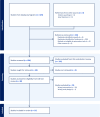Fentanyl harm reduction strategies among Latinx communities in the United States: a scoping review
- PMID: 39152433
- PMCID: PMC11328400
- DOI: 10.1186/s12954-024-01070-2
Fentanyl harm reduction strategies among Latinx communities in the United States: a scoping review
Abstract
Purpose: Fueled by the prescription opioid overdose crisis and increased influx of illicitly manufactured fentanyl, fentanyl overdoses continue to be a public health crisis that has cost the US economy over $1 trillion in reduced productivity, health care, family assistance, criminal justice, and accounted for over 74,000 deaths in 2023. A recent demographic shift in the opioid crisis has led to a rise in overdose deaths among the Latinx population. Harm reduction interventions, including the use of naloxone and fentanyl test strips, have been shown to be effective measures at reducing the number of opioid overdose deaths. The aim of this scoping review is to summarize naloxone and fentanyl test strip interventions and public health policies targeted to Latinx communities.
Methods: PubMed, CINHAL, Web of Science, Embase, and PsycINFO research databases using the keywords "fentanyl," "Latinx," "Harm Reduction," "Naloxone," and "Fentanyl Test Strips'' to identify studies published between January 1, 2013 and December 31, 2023. Endnote and Covidence software were used to catalog and manage citations for review of studies. Subsequently, studies that met inclusion criteria were then summarized using resulting themes.
Results: Twenty-seven articles met the inclusion criteria and were further abstracted for the scoping review. Of these articles, 77.7% (n = 21) included a naloxone intervention, while only 11.1% (n = 3) included a fentanyl test strip intervention. Furthermore, 30.1% (n = 8) of these studies were Latinx targeted, and 7.7% (n = 2) of the studies were adapted for Latinx populations. Four themes, including an overall lack of knowledge and awareness, a lack of access to harm reduction or opioid overdose prevention resources, an overall lack of culturally adapted and/or targeted interventions, and restrictive and punitive policies that limit the effectiveness of protective factors were highlighted in this scoping review.
Conclusion: Limited published research exists on the use of emerging harm reduction behaviors, such as the use of naloxone and fentanyl test strips as community intervention strategies to prevent opioid overdose deaths. Even fewer publications exist on the targeting and cultural adaptation of harm reduction interventions responsive to Latinx communities, especially those using theoretical approaches or frameworks to support these interventions. Future research is needed to assess the unique needs of Latinx populations and to develop culturally responsive programs to prevent opioid-related overdose deaths among this population.
Keywords: Fentanyl; Fentanyl test strips; Harm reduction; Latinx; Naloxone; Overdose.
© 2024. The Author(s).
Conflict of interest statement
The authors declare no that they have competing interests.
Figures





Similar articles
-
Evaluating fentanyl test strips as a harm reduction strategy in rural and urban counties: study protocol for a randomized controlled trial.Trials. 2024 Sep 4;25(1):587. doi: 10.1186/s13063-024-08440-y. Trials. 2024. PMID: 39232778 Free PMC article.
-
An individual-based dynamic model to assess interventions to mitigate opioid overdose risk.Harm Reduct J. 2024 Aug 13;21(1):146. doi: 10.1186/s12954-024-01069-9. Harm Reduct J. 2024. PMID: 39135022 Free PMC article.
-
Strategies used to reduce harms associated with fentanyl exposure among rural people who use drugs: multi-site qualitative findings from the rural opioid initiative.Harm Reduct J. 2024 Aug 24;21(1):154. doi: 10.1186/s12954-024-01062-2. Harm Reduct J. 2024. PMID: 39182116 Free PMC article.
-
Take-home naloxone programs for suspected opioid overdose in community settings: a scoping umbrella review.BMC Public Health. 2021 Mar 26;21(1):597. doi: 10.1186/s12889-021-10497-2. BMC Public Health. 2021. PMID: 33771150 Free PMC article.
-
The role of take-home naloxone in the epidemic of opioid overdose involving illicitly manufactured fentanyl and its analogs.Expert Opin Drug Saf. 2019 Jun;18(6):465-475. doi: 10.1080/14740338.2019.1613372. Epub 2019 May 16. Expert Opin Drug Saf. 2019. PMID: 31033357 Review.
References
Publication types
MeSH terms
Substances
LinkOut - more resources
Full Text Sources
Miscellaneous

